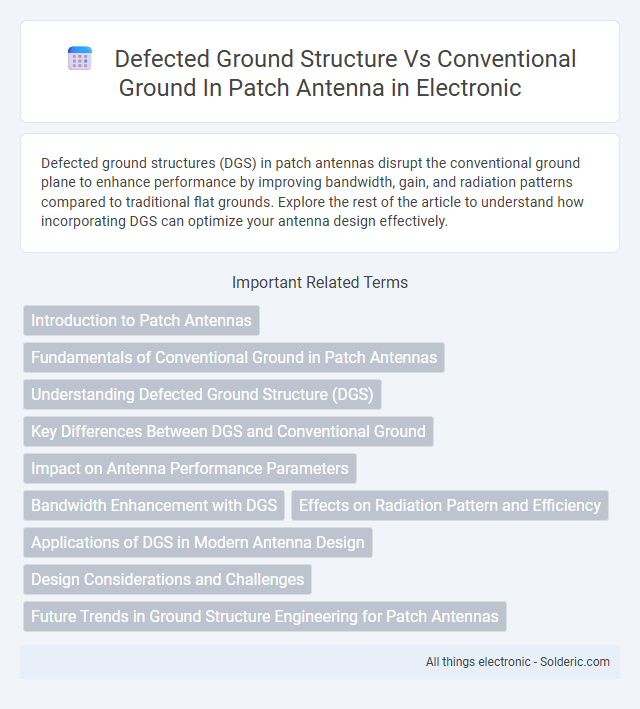Defected ground structures (DGS) in patch antennas disrupt the conventional ground plane to enhance performance by improving bandwidth, gain, and radiation patterns compared to traditional flat grounds. Explore the rest of the article to understand how incorporating DGS can optimize your antenna design effectively.
Comparison Table
| Feature | Defected Ground Structure (DGS) | Conventional Ground |
|---|---|---|
| Definition | Ground plane with intentional defects or patterns to enhance antenna performance | Continuous, plain ground plane without patterns or defects |
| Impedance Matching | Improves impedance bandwidth via slow-wave effect | Standard impedance matching, limited bandwidth |
| Bandwidth | Wider bandwidth due to resonance modification | Narrow bandwidth |
| Gain | Higher gain achievable through surface wave suppression | Moderate gain |
| Size Reduction | Enables antenna miniaturization by increasing effective inductance and capacitance | Conventional antenna size, dependent on resonant frequency |
| Fabrication Complexity | More complex due to etched patterns or slots | Simple and cost-effective |
| Surface Wave Suppression | Effective suppression leading to reduced mutual coupling | Limited suppression |
| Application | Used in compact, wideband, and multiband patch antennas | Used in conventional single-band patch antennas |
Introduction to Patch Antennas
Patch antennas, widely used in wireless communication, rely heavily on the ground plane for performance characteristics such as bandwidth, gain, and radiation pattern. Defected Ground Structure (DGS) introduces intentional disruptions or slots in the conventional ground plane to enhance antenna parameters like impedance bandwidth and radiation efficiency by controlling surface currents. Compared to conventional ground planes, DGS optimizes electromagnetic behavior, enabling compact designs with improved frequency selectivity and reduced mutual coupling.
Fundamentals of Conventional Ground in Patch Antennas
Conventional ground in patch antennas serves as a reference plane, providing a stable return path for currents and minimizing electromagnetic interference. It typically consists of a continuous metallic plane that enhances radiation efficiency and reduces signal loss by reflecting surface waves away from the patch. Understanding the role of conventional ground is essential for analyzing how modifications like defected ground structures impact antenna performance and bandwidth.
Understanding Defected Ground Structure (DGS)
Defected Ground Structure (DGS) in patch antennas involves intentionally etching or embedding patterns on the ground plane to disturb the current distribution, enhancing antenna performance characteristics such as bandwidth, gain, and mutual coupling reduction. Unlike conventional ground planes, DGS introduces defect-induced slow-wave effects that improve impedance matching and miniaturization without increasing antenna size. Understanding your antenna's ground structure can significantly impact its efficiency and frequency response in advanced wireless applications.
Key Differences Between DGS and Conventional Ground
Defected Ground Structure (DGS) in patch antennas introduces intentional disruptions in the ground plane, enhancing antenna performance by improving bandwidth, gain, and radiation patterns compared to conventional solid ground planes. DGS effectively suppresses surface waves and reduces mutual coupling in antenna arrays, leading to higher isolation and better impedance matching. Conventional ground planes offer simpler design and fabrication but lack the frequency selectivity and miniaturization benefits provided by DGS technology.
Impact on Antenna Performance Parameters
Defected Ground Structure (DGS) in patch antennas significantly enhances performance parameters by improving impedance bandwidth and reducing surface wave losses compared to conventional ground designs. The introduction of periodic defects disrupts the current distribution, resulting in higher gain and better radiation efficiency. Additionally, DGS effectively suppresses mutual coupling in antenna arrays, leading to improved isolation and overall antenna performance.
Bandwidth Enhancement with DGS
Defected Ground Structure (DGS) in patch antennas significantly enhances bandwidth by introducing a band-stop filter effect that alters the current distribution on the ground plane, resulting in improved impedance matching and reduced surface wave losses. Unlike conventional ground planes, DGS creates a discontinuity that shifts the resonant frequency and increases the antenna's effective bandwidth without increasing size. Experimental results show that patch antennas with DGS achieve bandwidth enhancements of up to 50% compared to traditional designs, making them ideal for multi-band and wideband applications.
Effects on Radiation Pattern and Efficiency
Defected Ground Structure (DGS) in patch antennas significantly alters the radiation pattern by suppressing surface waves, which enhances directivity and reduces back lobes compared to conventional ground planes. DGS improves antenna efficiency by minimizing energy loss and increasing gain through better impedance matching and reduced parasitic effects. Your patch antenna will exhibit a more focused radiation pattern and higher radiation efficiency when employing DGS rather than a traditional ground structure.
Applications of DGS in Modern Antenna Design
Defected Ground Structure (DGS) enhances modern antenna design by improving bandwidth, gain, and radiation characteristics, making it ideal for wireless communication systems, radar, and wearable devices. Unlike conventional ground planes, DGS introduces intentional defects that suppress surface waves, reduce interference, and enable miniaturization of patch antennas. Your antenna's performance can be significantly optimized in applications requiring compact size and high efficiency by integrating DGS technology.
Design Considerations and Challenges
Defected ground structures (DGS) in patch antennas introduce intentional perturbations in the ground plane to enhance parameters like bandwidth, gain, and impedance matching, requiring precise geometric design to avoid unwanted resonances. Design considerations include optimizing the shape, size, and position of the defect patterns to control electromagnetic wave propagation without significantly increasing antenna size or complexity. Challenges involve maintaining structural integrity, minimizing fabrication errors, and ensuring stability across frequency bands, as conventional ground planes offer simpler, more predictable performance but lack the enhanced tuning capabilities of DGS.
Future Trends in Ground Structure Engineering for Patch Antennas
Future trends in ground structure engineering for patch antennas emphasize Defected Ground Structures (DGS) due to their superior ability to enhance antenna performance through miniaturization, bandwidth improvement, and electromagnetic interference reduction. Research increasingly explores advanced DGS designs leveraging metamaterials and reconfigurable elements to optimize antenna efficiency and adaptability in complex communication environments. Your antenna systems can benefit significantly from these innovations by achieving higher gain and better radiation patterns compared to conventional ground planes.
defected ground structure vs conventional ground in patch antenna Infographic

 solderic.com
solderic.com